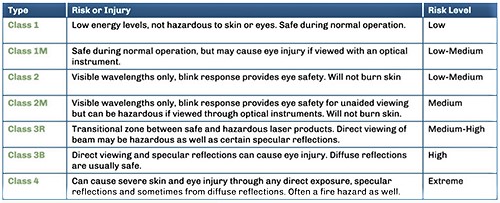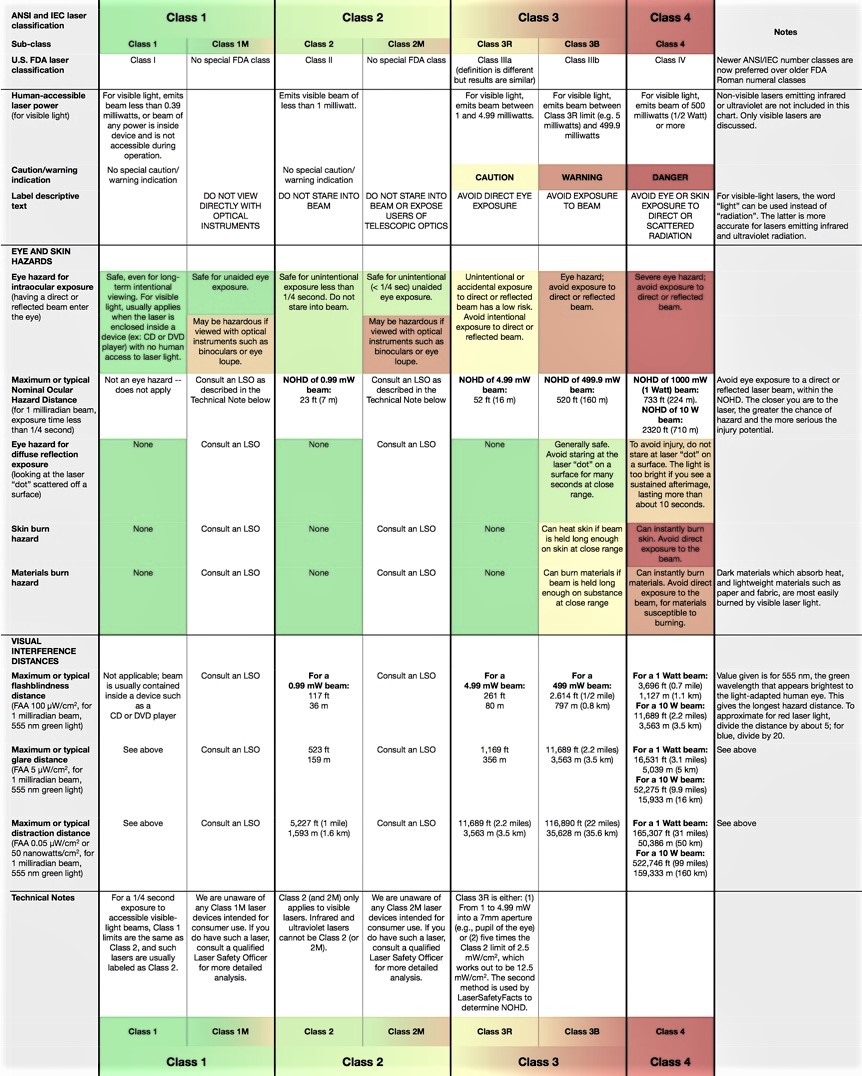Laser Safety
Laser Safety Classification, Equipment, and Inspection
Cal OSHA's Construction Safety Orders (Title 8, Nonionizing Radiation 1801) require that individuals working with/around lasers be aware of the risks and hazards, and receive proper training.
Due to the potential hazards of laser technology used on campus, the University of San Francisco requires that those expected to work with or around lasers receive proper training. The safe use of laser technology begins with proper labeling on equipment and around hazardous areas. Laser devices must be properly labeled, machines should be regularly inspected to ensure that they operate as designed and specified, and proper personnel safety equipment should be available.
In addition, adhering to the Laser Safety requirements involves:
- Safety training as requested and required.
- The determination of appropriate signage and protective equipment.
- The registration of class 3R, 3B, and 4 lasers.
- The inspection of laser equipment (both machinery and safety equipment).
- The review of laser facility designs.
- The investigation of incidents and injuries.
- A regular audit inspection and ongoing compliance with the aforementioned requirements.
Training
Important: You must review the material and complete the quiz in the same session for the time you spend training to be recorded accurately. Most courses take about 30 minutes to complete.
Use the following link(s) to go to the training:
Laser Safety in the Laboratory Training
Charts and Laser Classifications
Laser Classifications
Note: The "M" after a classification indicates increased hazard risk while viewing the laser beam through a magnifying optic, such as a fiber inspection scope or an eye loupe.
Class 1
A Class 1 laser system is relatively safe, as it is generally considered to be unable to produce damaging levels of radiation during normal operation. For this reason, they are exempt from state or federal control measures and surveillance.
Class 2
A Class 2 laser system emits in the visible part of the light spectrum, between 400 and 700 nanometers. Eye protection is often recommended for people with sensitivity or an aversion to bright lights.
Class 3
A Class 3 laser system has two subclasses: 3R and 3B. The 3R subclass, also commonly referred to as 3A or IIIA, has reduced requirements that are applied to Class 3R lasers in comparison to Class 3B lasers. Both subclasses of Class 3 lasers are hazardous when viewed, either when viewed directly or when viewing the specular reflection off a shiny surface.
Class 4
A Class 4 laser system presents a hazard to both eyes and skin from the direct beam, specular reflections, and diffuse reflections. A Class 4 laser often also presents a fire hazard.
Keep in mind that the laser classification describes the hazard level generally, but can not account for all uses and the presence of all equipment. Depending on both the equipment interacting directly with the laser and the equipment adjacent to the laser, the risks of laser use may become more serious than the classification may suggest.
The use of all Hazard Class lasers (ie. 3R, 3B, and 4) must be approved by the Environmental Health & Safety Office (EH&S) before installation or use. In addition, any acquisition, transfer, and/or removal of Hazard Class lasers must be made known to the Environmental Health and Safety Office. Laser devices that are assembled at the University of San Francisco may receive a hazard evaluation by contacting the EH&S Office.
Laser devices which require registration include, but are not limited to:
- Optical bench-top lasers.
- Light sources for microscopy and measurements.
- Medical devices that utilize laser technology.
Most Class I laser devices do NOT require registration. Examples of Class 1 laser devices include:
- laser printers
- imaging devices
- telecom devices
Examples of Class 1 laser devices that MUST be registered with the EH&S Office include:
- cell sorters
- particle counters
...or any other scientific device with a laser cavity accessible by the user. These laser devices must be registered to ensure that safety interlocks and/or protective optical filters may be checked for efficacy. Schedule an inspection with EH&S regarding laser safety if your equipment includes any of the following:
- protective laser housing
- safety interlocks
- labeling
- hazard posting
- indicators
- Personal Protective Equipment (PPE)
- and other ancillary hazards
Required Laser Signage
When operating lasers that present any level of risk, signage must be present and displayed prominently to serve as both a warning and a reminder of hazards within the operational area of the laser.
Specifically, for Class 3B and Class 4 lasers, ensure the signs include:
- Type and Classification
- Wavelengths
- Power Output
Signage must also be present during procedures and experiments that present an increased or unique risk. For example, signage should always be posted during the laser alignment process.
Laser Pointers
Laser Pointers are sometimes used on campus during presentations. Avoid pointing the laser into your own eyes or the eyes of others, regardless of the Hazard Classification as lasers of any power level can damage eyes. Also, note that many Laser Pointer devices are now classified as Hazard Class 3R due to the increased power output from special diodes which produce red light wavelengths that the eye is very sensitive to. While these devices DO NOT require registration with EH&S, it is advisable to check for the presence of the required label which includes:
- the laser hazard symbol
- the laser classification
- the laser wavelength
- the maximum laser output

